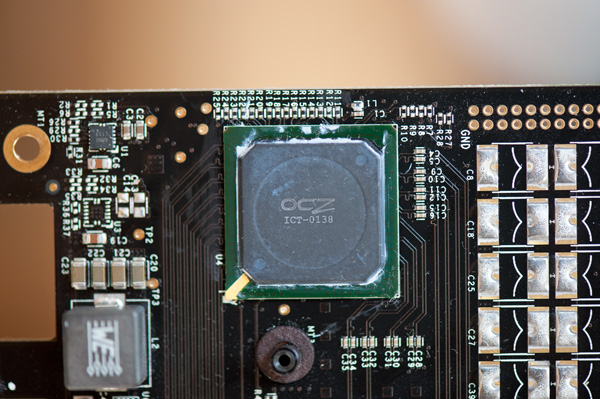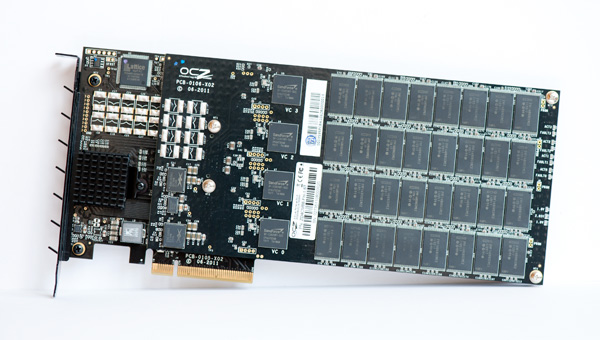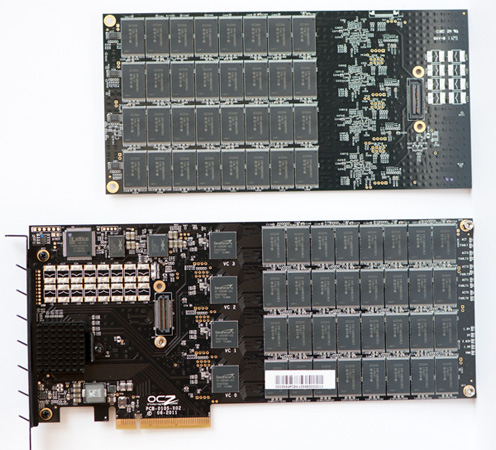OCZ Z-Drive R4 CM88 (1.6TB PCIe SSD) Review
by Anand Lal Shimpi on September 27, 2011 2:02 PM EST- Posted in
- Storage
- SSDs
- OCZ
- Z-Drive R4
- PCIe SSD
In our last SandForce SSD roundup I talked about how undesirable the consumer SSD market is, at least for those companies who don't produce their own controllers and/or NAND. There's a downward trend in NAND and SSD pricing, which unfortunately squeezes drive manufacturers as they compete for marketshare. The shrinking margins in the consumer SSD space will ultimately drive companies out of the business, consolidating power in those companies who are fine operating with slim margins. There are other effects, such as insufficient validation testing that result from this price crunch.
Public companies are under an even greater pressure to maintain high profit margins. Investors don't care about good product, they care about good returns. What is a public SSD manufacturer like OCZ to do? Go after the enterprise market of course.
OCZ has quietly addressed the enterprise SSD space for a while now. Today you can custom order an OCZ Deneva 2 SSD which is an enterprise focused SF-2000 based solution. OCZ's enterprise drives are fully customizable down to the controller, firmware and NAND type on-board. If you want an SF-2000 drive with SAS support and SLC NAND, OCZ will build it for you.
In the enterprise segment where 1U and 2U servers are common, PCI Express SSDs are very attractive. You may not always have a ton of 2.5" drive bays but there's usually at least one high-bandwidth PCIe slot unused. The RevoDrive family of PCIe SSDs were targeted at the high-end desktop or workstation market, but for an enterprise-specific solution OCZ has its Z-Drive line.
We introduced the Z-Drive R4 in our Computex coverage earlier this year - it's a beast. The Z-Drive R4 is a multi-controller PCIe solution that uses either 4 or 8 SF-2000 controllers behind a SAS-to-PCIe 2.0 x8 controller. The breakdown is as follows:
| OCZ Z-Drive R4 Lineup | ||||||
| CM84 | CM88 | RM84 | RM88 | |||
| Capacities | 300/600/1200GB | 800/1600/3200GB | 300/600/1200GB | 800/1600/3200GB | ||
| NAND | MLC | MLC | MLC | MLC | ||
| Interface | PCIe Gen 2 x8 | PCIe Gen 2 x8 | PCIe Gen 2 x8 | PCIe Gen 2 x8 | ||
| Form Factor | Half Height PCIe | Full Height PCIe | Half Height PCIe | Full Height PCIe | ||
| Dimensions LxWxH | 168.55 x 68.91 x 17.14 mm | 242 x 98.4 x 17.14mm | 168.55 x 68.91 x 17.14 mm | 242 x 98.4 x 17.14mm | ||
| SSD Controllers | 4 x SF-2282 | 8 x SF-2282 | 4 x SF-2582 | 8 x SF-2582 | ||
| Power Failure Protection | N | N | Y | Y | ||
| Max Read | 2000MB/s | 2800MB/s | 2000MB/s | 2800MB/s | ||
| Max Write | 2000MB/s | 2800MB/s | 2000MB/s | 2800MB/s | ||
| Max Random Read | 250K IOPS | 410K IOPS | 250K IOPS | 410K IOPS | ||
| Max Random Write | 160K IOPS | 275K IOPS | 160K IOPS | 275K IOPS | ||
The xM84s are half height solutions with four controllers while the xM88s are full height with eight controllers. The C-series use SF-2282 controllers while the R-series use SF-2582. The main difference there is the support for power failure protection. The R-series boards have an array of capacitors that can store enough charge to flush all pending writes to the NAND arrays in the event of a power failure. The C-series boards do not have this feature.
Despite the spec table above, OCZ also offers customized solutions as I mentioned above. The table above simply highlights the standard configurations OCZ builds.
For today's review OCZ sent us a 1.6TB Z-Drive R4 CM88. We have a preproduction board that has a number of stability & compatibility issues. OCZ tells us these problems will be addressed in the final version of the drives due to ship in the coming weeks. OCZ expects pricing on this board to be somewhere in the $6 - $7/GB range depending on configuration. Doing the math that works out to be anywhere between $9600 - $11200 for this single SSD. OCZ typically sells SF-2281 based SSDs at around $2/GB, even accounting for the extra controllers on-board there should be a hefty amount of profit for OCZ in the selling price of these Z-drives.
As with the RevoDrive X2 models the Z-Drive R4 CM88 uses two PCBs to accommodate all of its controllers. Each PCB is home to four SF-2282 controllers and 64 Intel 25nm MLC NAND devices (8 controllers, 128 devices total). Each NAND device has two 8GB die inside, which works out to be 2048GB of NAND on-board. This is an absolutely insane amount of NAND for a single drive. Remember each 8GB MLC NAND die (25nm) is 167mm2, which means this Z-Drive R4 has 42752mm2 of 25nm silicon on-board. A single 300mm wafer only has a surface area of 70685mm2 (even less is usable), which means it takes more than half of a 300mm 25nm MLC NAND wafer to supply the flash for just one of these drives. Roughly 27% of the NAND is set aside as spare area, exposing 1490GiB to the OS.
Thanks to the eight SF-2282 controllers and tons of NAND in close proximity, OCZ requires 100 CFM of air to properly cool the Z-Drive R4. This is clearly a solution for a rack mounted server.

It's OCZ branded but this is a Marvell SAS controller - the same driver works on the RevoDrive 3 X2 and the Z-Drive R4
OCZ continues to use its VCA 2.0 architecture on the Z-Drive R4. Details are still vague but OCZ claims to have written its own driver and firmware for the Marvell SAS controller on the Z-Drive R4 that allows it to manage redirection of IOs based on current controller queue depths rather than a dumb RAID-stripe. The driver accumulates IOs and redestributes them to the drive's controller array, to some degree, dynamically. OCZ's VCA also allows TRIM to be passed to the array although Microsoft's OSes won't pass TRIM to SCSI/SAS drives. You can use OCZ's Toolbox to secure erase the drive but there's no real-time TRIM available, this is a Microsoft limitation that impacts all SAS based drives.
The Test
This is going to be a bit of a disappointing set of performance graphs as it is our first real foray into the world of enterprise SSD testing. You will see results from the RevoDrive 3 X2 as well as a single Vertex 3 and Intel's X25-E, however we have no other high-end PCIe SSDs at our disposal for comparison. We have put in a request to FusionIO for a competing solution however it appears to have fallen on deaf ears. We will use this review to begin assembling our enterprise SSD data and hopefully in the coming weeks and months we'll be able to have a set equivalent to what we have in the consumer space.
We also had to run the Z-Drive R4 on our old X58 testbed instead of our H67 system as it wouldn't complete any tests on our H67 platform. OCZ attributes this to an issue with the preproduction Z-Drive boards which it says will be corrected by the time mass production begins.
| CPU |
Intel Core i7 965 running at 3.2GHz (Turbo & EIST Disabled) for Enterprise Bench Intel Core i7 2600K running at 3.4GHz (Turbo & EIST Disabled) - for AT SB 2011, AS SSD & ATTO |
| Motherboard: |
Intel DX58SO (Intel X58) Intel H67 Motherboard |
| Chipset: |
Intel X58 Intel H67 |
| Chipset Drivers: |
Intel 9.1.1.1015 + Intel RST 10.2 |
| Memory: | Qimonda DDR3-1333 4 x 1GB (7-7-7-20) |
| Video Card: | eVGA GeForce GTX 285 |
| Video Drivers: | NVIDIA ForceWare 190.38 64-bit |
| Desktop Resolution: | 1920 x 1200 |
| OS: | Windows 7 x64 |












57 Comments
View All Comments
josephjpeters - Tuesday, September 27, 2011 - link
And why is that? Because of the supposed high failure rates? Can you supply any real information about this?OCZ has less then 1% failure rate. There may be more then 1% of customers who have "issues" but they aren't related to the drive. User error plays a pretty big role, but of course it MUST be OCZ's fault right?
Enterprise customers are professionals who know how to install serious hardware like this. And if they don't? OCZ will help install it for them on site. That's what enterprise companies do!
Troff - Tuesday, September 27, 2011 - link
I don't believe that 1% number for a second. First of all, I read some return stats from a store that listed the RETURN rate at just below 3%. Secondly, I know of 5 very different systems with Vertex 3 drives in them. All 5 have recurring lockups/BSODs. The people who built and run these systems write their own filesystems. They are extremely knowledgeable. If they can't make them run properly, they are not fit to run outside of a lab environment.That said, I suspect it's as much Sandforce that's the problem as it is OCZ.
josephjpeters - Wednesday, September 28, 2011 - link
I think it's an Intel problem. But NooOoOo... it can't be an Intel problem...geddarkstorm - Wednesday, September 28, 2011 - link
From all the data I've been seeing, it seems to be a SATA III issue, and an issue with motherboards not being reading for such high volumes of data flow. Mechanical drives can get no where near SSD speeds, and I don't think manufacturers were really expecting how fast they'd go on SATA III (almost pegging it out at times, and it's brand new!).josephjpeters - Wednesday, September 28, 2011 - link
Exactly. It's not an OCZ issue, it's the motherboard. When will someone step in and take the blame?Beenthere - Tuesday, September 27, 2011 - link
SSDs appear to be an on-the-job learning program for SSD manufacturers with all the issues that currently exist.I do not however believe they are selling SSDs at low margins.
Enterprise won't use SSDs yet for the same reason informed consumers won't use them - they have serious reliability and compatibility issues. Unless you can afford lost data and a hosed PC, SSDs are not even an option at this point in time. Maybe in a couple more years they will sort out the problems that should have resolved long agao?
dave1231 - Tuesday, September 27, 2011 - link
I wonder really how much a consumer SSD costs to produce. Saying that slim margins will force companies out of business if there's a big markup on a 128GB is not true. These same drives were $100s of dollars last year and probably still aren't good value today. Unless you're saying consumers are waiting for the .50c/GB drive.josephjpeters - Tuesday, September 27, 2011 - link
It's roughly 20% margins and the price of an SSD is directly related to the cost of Flash. Owning the controller IP is key in maintaining solid margins.Enterprise drives will drive flash demand which will lead to economies of scale that result in cheaper Flash prices and consequently cheaper consumer SSD's.
ChristophWeber - Tuesday, September 27, 2011 - link
Anand wrote: "I've often heard that in the enterprise world SSDs just aren't used unless the data is on a live mechanical disk backup somewhere. Players in the enterprise space just don't seem to have the confidence in SSDs yet."I use an SSD in an enterprise environment, a first gen Sandforce model from OWC. I do trust it with my main workload - database and web server in this case, but of course it is still backed up to mirrored hard drives nightly, just in case.
I'd have no qualms deploying a Z-Drive R4 in one of our HPC clusters, but it'd be an RM88 model with capacitors, and I'd still run the nightly rsync to a large RAID unit. Now if someone would finally signal they want to spend another $100k on a cluster, and I'll spec a nice SSD solution for primary storage.
nytopcat98367 - Tuesday, September 27, 2011 - link
is it bootable? can it b used 4 a desktop too?